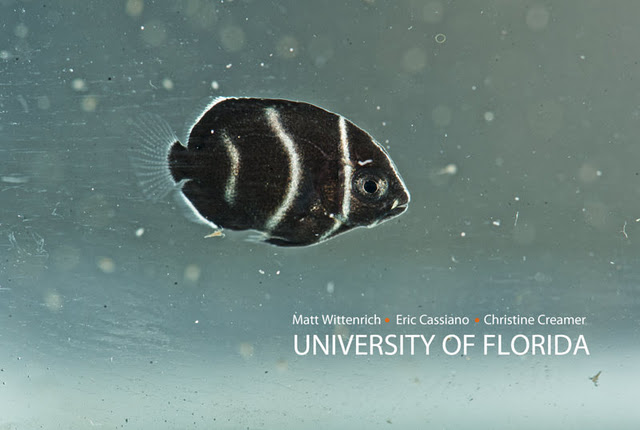On the heals of a close call with breeding the Schooling Bannerfish, Heniochus diphueretes, the marine ornamental team at the University of Florida’s Tropical Aquaculture Lab doubled down and has just released photographs and video of what is probably the world’s first captive-bred Koran Angelfish, Pomacanthus semicirculatus. Once again, these eggs were not spawned in Florida, but were collected over 1000 miles away at the Columbus Zoo and Aquarium. And perhaps the most shocking news yet is how quickly it took for these angelfish to go from egg to prolarvae to larva to fully settled juvenile – only 26 days (and actually, if you really look at it, metamorphosis and settlement start several days earlier).

To put this in perspective, to date this would represent possibly only the 5th Pomacanthus angelfish to be captive bred, with prior successes starting with Martin Moe’s work utilizing wild collected eggs from Pomacanthus arcuatus and P. paru to create captive-bred P. arcuatus and a P. arcuatus X paru hybrid. Then, decades pass, until we learn of Pomacanthus angelfish being captive-bred in Taiwan, specifically P. maculosus and P. asfur.
But getting back to an angelfish that settles in less than a month – WOW. As a breeder, it is generally considered that the pelagic larval period is the riskiest time for a project – the longer the pelagic larval phase, the more difficult a project you should anticipate. For comparison, I should start with a commonly bred marine species – the Sunrise Dottyback (Psuedochromis flavivertex). The larval period for that species is generally 28 to 35 days post hatch, whereas we’re seeing a shorter larval period for a pelagic spawning angelfish!

The next shortest larval timelines for Angelfish are roughly 35-40 days as observed by Martin Moe with his Atlantic Pomacanthus, and then Frank Baensch’s 40 day larval period for the Pygmy Angelfish, Centropyge argi. Still compare that to the fact that other fish can take much longer. For example, Harlequin Filefish, Oxymonacanthus longirostris, take roughly 56 days to settle, with Xanthichthys mento taking over 100 days.
Then again, Baensch puts the larval timeline of Centropyge debelius close to 120 days! Indeed, when you look around the breeding world we can speculate that Pomacanthus semicirculatus, with only a 26 day larval period, could possibly represent one of the easiest pelagic spawning marine fish to rear. Now all you have to do is know the protocol and get the eggs. And there’s the hiccup – this time around, the Rising Tide blog was very light on details, so for now we can only drool over pictures…and video (but you have to go to the blog to see the amazing video!)

The team of Dr. Wittenrich, Eric Cassiano and Christine Creamer, hopes that what they learn working with Pomacanthus semicirculatus will transfer well to one of Rising Tide’s target species, the Emperor Angelfish (Pomacanthus imperator). We wish the team all the luck in the world. And once again, the Rising Tide Initiative proves that collaborative efforts, “open source breeding”, can be a huge win for everyone.



